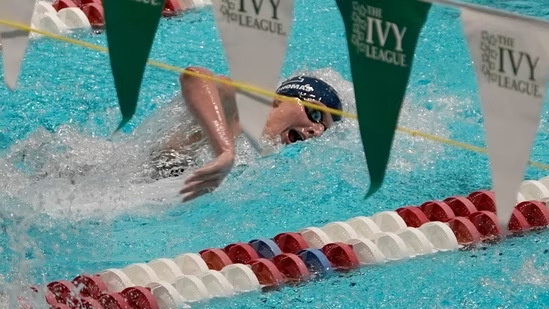Not so simple: Debate over gender identities in sport
It’s been weeks since FINA, ruling body of world aquatics, announced their regulations preventing the participation of transgender athletes in women’s events and all we have is emotion. From World Athletics boss Seb Coe’s triumphal ‘biology trumps gender’ to the trans community activists calling the regulations ‘unscientific’.  PREMIUM
PREMIUM
FINA were not the first international federation (IF) to announce transgender regulations, but made the biggest noise because of their presence in US sport. In March 2021, rugby union had barred trans women from competing in women’s events. Two days before the FINA ruling, world cycling tightened its eligibility criteria for transgender athletes. Rugby league followed two days after FINA.
These current changes might seem rapid and radical, but IFs have had more than 15 years to put science to use around transgender eligibility but chose to sit on their hands. In 2004, the IOC allowed transgender athletes to compete at the Olympics in Athens with stipulations. In 2021, weightlifter Laurel Hubbard became the first transwoman Olympian in Tokyo. Between 2004 and 2021, the better-funded sports like athletics and football, showed no urgency to stay in step with rapidly changing gender identities.
Not enough science has meant not enough clarity nor any scientific data about ‘disproportionate advantage’ of transwomen athletes in female sport. Alun Williams, geneticist, biomedical scientist and reader (sports and exercise genomics) at Manchester Metropolitan University’s Institute of Sport says, “I don’t think there has been enough research to fully understand all the differences between transwomen performance or cisgender women performance.” He says, “What has emerged over the last few years has been a lot of discussion and debate and not a lot of primary scientific evidence.”
Gender identities have long been contested in sport, “This issue has a long history going way back. If there was a will, then necessary funds could have been diverted several years ago to do the research that will be required to have more solid evidence now on which to base their regulations.” IFs he does admit may have been taken by surprise by the speed of societal changes, “They should have had that foresight but they’ve been a little surprised perhaps by how things have changed.”
Williams has spent more than two decades researching what genetic factors that help people perform differently from others across sport and found himself in the gender debate when the question of DSD (Differences of Sexual Development) athletes arose, after bans on Indian sprinter Dutee Chand and South African middle distance runner Caster Semenya.
Even though FINA has clubbed them together, Williams says, “There should be separate policies and regulations for DSD and transgender athletes. The biology for transgender athletes is relatively clear. For DSD athletes to even label them all as one category is limited because there are so many variations, even in one type of DSDs. A particular genetic change in their DNA can make them different from somebody with the same type of DSD.”
The FINA position on transgender athletes, Williams says, “is quite reasonable and even though unfortunate for trans women athletes and I mean that.” Scientists break down “genetic advantage” in two types – common ones that have small effects (the fast twitch fibre gene, for example) and rare ones, that have very large effects – like the off-the-charts haemoglobin levels of Finnish cross country skier Eero Mäntyranta, which came from a mutation in his family gene. All of these however are equally available to men and women.
The difference between male and female sporting performance returns to their fundamentals, their genetic make-up. The SRY gene on the Y (male) chromosome which enables most men to produce high testosterone (T) levels through puberty and most of their adult life. Lowering testosterone levels has become a key marker in a trans woman’s transition. Except, Williams says, lowered T-levels “does not remove the advantage someone would already have acquired if they have fully gone through puberty. That’s when the skeleton grows, the muscle mass grows, the heart and lungs grow as well…”
Even after lowering T levels, Williams reckons “probably less than half” of the physical advantages of the post-puberty male are reduced. The trans woman will still have “a larger skeleton, longer limbs, they will still be taller, they will have larger muscle mass, they will have a larger heart” and every advantage that follows.
When asked for a number on the difference between male and female sporting performance Williams said, “in many sports like athletics and swimming the average difference in performance between men and women is about between 10-15%. But in sports that are much more reliable on muscle mass and strength, particularly upper body, then those differences can be up to about 50% on average.” Does lowering the T-level then erase the difference? “The answer is that with all the evidence so far that is not the case.”
World Rugby’s summary of transgender biology and performance research document, says reducing T levels, “removes only approximately one fifth of muscle and strength advantages.” The evidence was drawn not from trans women rugby players but ‘studies of biological differences, effects of T suppression and known injury and performance factors.’
In 2015, Joanna Harper, medical physicist, runner and transgender rights activist published a study of data collected from eight trans women runners to show that their race times after transition belonged to the appropriate age-categories of other women runners. According to an article in Science dated 25 July 2018, Harper showed similar results for a transgender rower, cyclist and a sprinter, to indicate that “previous male levels of testosterone does not confer an enduring athletic advantage.”
But once again, a thorny subject is left with far too little scientific evidence, across a far too small a sample size, with far too many limitations. Williams says, “Most science requires to get groups of a certain size to run your statistics... there aren’t that many elite transgender athletes. Some of the measurements that have been done are quite generic ones. To use in a lab or field setting but not specific to individual sports.” Tests run on trans throwers or jumpers won’t apply or reveal more about transitioning swimmers.
It shouldn’t have come down choosing between fairness or inclusion, but the lack of foresight and science has brought us here. Dealing with residual guilt of picking one over the other.
Experience unrestricted digital access with HT Premium
Explore amazing offers on HT + Economist Start 14 Days Free Trial Already Subscribed? Sign In
Disclaimer: The copyright of this article belongs to the original author. Reposting this article is solely for the purpose of information dissemination and does not constitute any investment advice. If there is any infringement, please contact us immediately. We will make corrections or deletions as necessary. Thank you.







